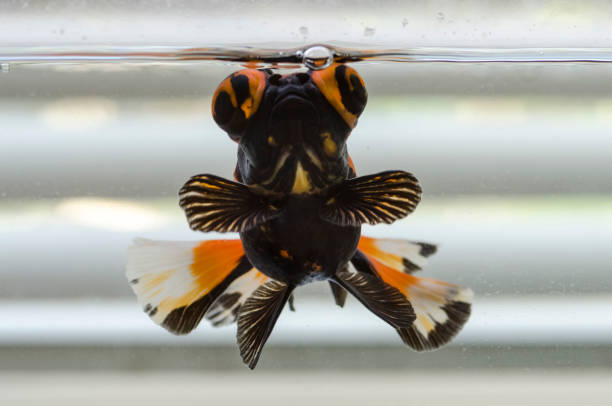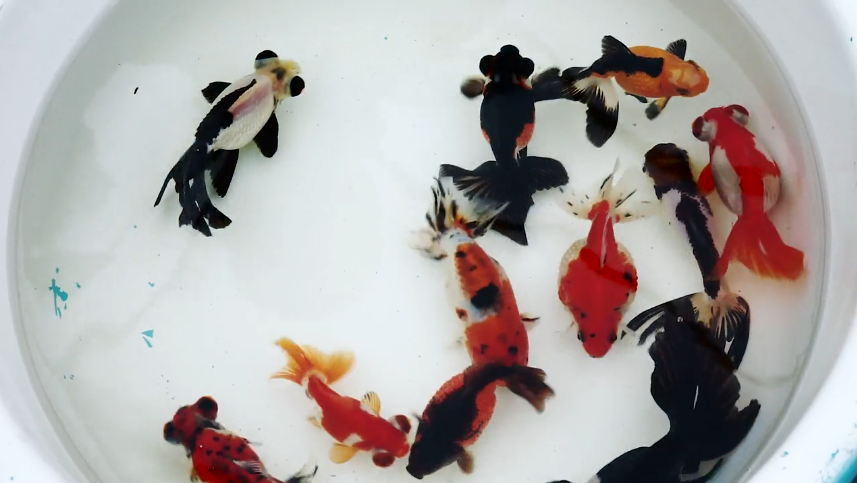Butterfly Tail Goldfish is one of the most elegant and sought-after goldfish varieties. Aquarists around the world love to keep unique goldfish breeds, but raising the butterfly tail goldfish is an incomparably rewarding experience. This is your one-stop guide to everything on the butterfly tail Goldfish, including care tips and tank setup.

Discover the Beauty of Butterfly Tail Goldfish
This breed of aquarium goldfish has protruding eyes and stunning fins that help them swim gracefully. The Butterfly tail’s origin can be traced to the 1800s and early 1900s in China, where they were bred and crossbred to produce their colorful forms.
Physical Characteristics

The Butterfly tail goldfish appearance can be characterized by their long, flowing, lobed tails. These incredibly stunning goldfish are so named because their tail shapes resemble a butterfly’s wings.
The best way to appreciate this goldfish is by viewing it from above. You can observe its tail angled horizontally to form its beautiful shape. It has various coloration and fascinating features, making it stand out among other fancy goldfish.
Its lovely colors range from red to blue, red and white, calico, black and white, matte white, and lavender. Their scales may also appear nacreous or metallic. This goldfish’s body structure is deep and stocky, with an egg-like shape similar to most fancy goldfish.
Ideal Tank Conditions
A goldfish as stunning as the butterfly tail goldfish deserves all the extra care and attention. Creating a healthy environment for your goldfish is the only way to keep them vibrant and healthy.
The butterfly tail goldfish tank conditions must be set to stable parameters because they are sensitive to temperature and water quality changes. They have specific requirements regarding the tank setup, water quality, and temperature.
Butterfly-tail goldfish can grow quite large, often up to 8 inches long. Due to their large size, the ideal goldfish tank size should have a minimum of 20 gallons of water per fish. The tank must also be larger and wider, as these species prefer tanks that are wide enough to provide ample space for swimming around.
These goldfish are highly delicate and sensitive to changes in their living environments, so it’s crucial to maintain stable conditions to improve their survival. The ideal water temperature for this goldfish is between 65-72°F, and the pH should be kept at 6.5-7.5. A high-quality goldfish filtration system is also important as it provides a clean ecosystem and avoids the buildup of toxins.

Author’s Note: For some planted tank decor tips check out our article on The 8 Best Live Plants for Goldfish Aquariums, there are indeed live plants that can thrive in a goldfish habitat!
Diet and Nutrition
Feeding your goldfish a proper diet and nutrition is crucial for their growth and health. The Butterfly tail goldfish’s diet should include flakes, pellets, live and frozen foods, and vegetables because these species are omnivores.
Their food must contain high-quality nutrition served in a quantity that feeds your pet well without overfeeding it and contaminating their environment.
The live or frozen food variety could include food types like brine shrimp, bloodworms, and daphnia, and vegetables like peas and lettuce could improve digestion.
Feeding goldfish is a peculiar task because they require frequent meals throughout the day rather than feeding them in large portions at once. The rule of thumb is to feed them an amount of food that can be consumed in 3 minutes about 2-3 times a day.
Considering the quantity and quality of their food is essential to avoid health problems like swim bladder, often caused by overfeeding.
For more on feeding your aquatic pets check out The Ultimate Guide to Fish Food: Pros and Cons & Best Choices!
Common Health Issues
Like most fancy goldfish, the butterfly tail goldfish are susceptible to several health issues. The most common diseases affecting this species include bacterial infections, fungal infections, ich, swim bladder disease, fin rot, and parasites.
The best way to avoid these diseases is to maintain a healthy tank with proper filtration and stable water quality parameters. Keeping your pet in the best shape comes from looking out for useful goldfish help tips that can help constantly improve their life.
If you check on your goldfish constantly, symptoms like lethargy, discoloration, or abnormal swimming behavior can be noticed early in case of health issues. If you notice these, treatment needs to be given immediately. Contact your veterinarian or fish health specialists for appropriate diagnosis and treatment.
Breeding Butterfly Tail Goldfish

Butterfly tail goldfish breeding begins with careful selection of the right breeding pairs. Before choosing their breeding partners, you need to consider factors like size, fin shape, and age. The next step in breeding goldfish is to set up a separate breeding tank so there’s enough room for breeding and they can be observed.
Breeding butterfly tail goldfish is very rewarding and fascinating. You can observe the goldfish engage in courtship behavior like chasing and flaring their fins. The male goldfish chase the female around the breeding tank, with the aim of nudging her abdomen to stimulate the release of eggs.
Once the eggs are released, the male fertilizes them. Spawning often results in hundreds or thousands of eggs. After spawning, the adult tanks should be separated from the fry so they won’t eat them.
Raising and caring for goldfish fry is not easy, especially during the first few weeks, which are critical for their development. A small batch of fry can be kept in a 10-20 gallon tank. The tank should be well-filtered with the temperature kept at 75-80°F.
Compatibility with Other Fish
This breed of goldfish is peaceful and sociable, and it enjoys being kept in groups. Building a community tank is not difficult because it can be kept with other fancy goldfish and easily bonds with its partners. Butterfly tail goldfish compatibility is easy to figure out because of their calm and friendly behavior.
Some of the most suitable tank mates for these species include ranchu, oranda, ryukin, and lionhead goldfish. You can include a few invertebrates like snails or large shrimps. Avoid pairing them with tiny fish and small shrimp, as they may eat them.
Special Care Requirements
As said earlier, this goldfish species is elegant and needs specific care to remain vibrant and long living. Proper goldfish grooming involves raising your goldfish to its full potential by providing stable water parameters, care, and nutrition.
Regular goldfish maintenance should be done weekly with 20-30% of water changed to remove waste and maintain the water quality. Dead plant matter in the tank should be removed, and algae should be cleaned from the glass to keep the tank clean.
Without maintaining proper water parameters, the tank’s water quality can degrade, which can cause a wide range of issues from cloudy aquarium water to illness and mass fish die off.
Conclusion
Butterfly tail goldfish are stunning cold-water goldfish sought after for their tail fins that spread out in the most beautiful way. Raising and breeding this variety of unique aquarium fish is a fascinating hobby for several goldfish enthusiasts.
By understanding their unique characteristics and following these goldfish care tips in this guide, raising your butterfly tail goldfish to maturity would be an easy and rewarding journey. If you are searching for the perfect goldfish to add a touch of color and elegance to your aquarium, this beautiful, ideal goldfish is all you need.


